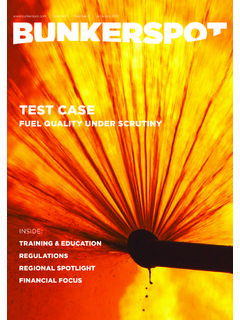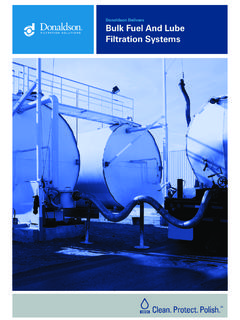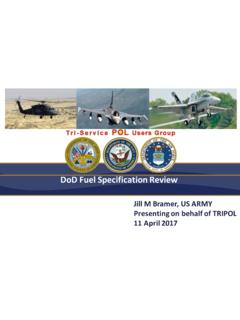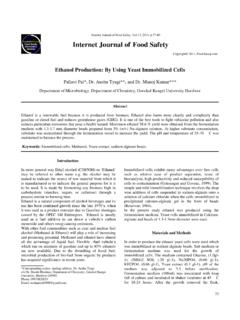Transcription of www.bunkerspot.com Volume 10 Number 2 …
1 INDEPENDENT INTELLIGENCE FOR THE GLOBAL BUNKER 10 Number 2 april /May 2013 Inside: Environmental Issues Market Analysis Shipping Trends Fuel Procurement News & EventsLNG steps up the paceCourtesy of Port of GothenburgApril/May 2013 As the onslaught of microbiological attack takes hold, the conditions become more habitable for other microorganisms including aerobic bacteria, fungi and yeasts where safeguards such as the use of H2S scavenger type fuel additives help to mitigate the risks that this hazard poses. While the carry-over of H2S is possible from upstream processes, the leading cause for H2S presence onboard is from sulphate reducing bacteria that consume the fuel and generate H2S. With over 200 species of SRB known, the one most commonly found in marine fuel storage tanks has been identified as Desulfovibrio desulfuricans.
2 While this anaerobic bacterium can survive at extreme conditions of minus 195 C to minus 100 C for several hours, when other types of animal life would simply die, it typically thrives at the oil and water interface layer with a temperature range between 30 C and 40 C at neutral pH levels. However when introduced to environments outside of these conditions, the growth would still carry on, albeit at a relatively slower rate. Nevertheless, since bacteria can double in population every 15 to 20 minutes, exponential growth rates from a single cell can lead to that rotten egg Technology UpdateAlbert Leyson of Drew Marine looks at how shipowners can cut their bunker bills by tackling the microbial growth in fuel tanksMicrobial growths and their effect within the marine industry are quite well known.
3 Left to grow unabated on the ship s hull, for example, various forms of microscopic marine life will colonise and create a biofilm, which eventually paves the way for barnacles and the like, in just a matter of marine fouling negatively impacts hull efficiency and subsequently increases fuel consumption, as additional fuel would be necessary to overcome the added drag created by the now fouled hull form and skin resistance. Similarly, the fouling of fuel oil storage tanks due to microbial growth can also impact overall vessel efficiency, since specific sulphate reducing bacteria (SRB) oxidise hydrogen compounds in fuel that directly result in fuel losses. Furthermore, as the bacteria eats the fuel, it also reduces sulphate ion concentration, which comes from the sulphur content in the fuel, into hydrogen sulphide (H2S), thus creating a potential safety hazard in the surrounding atmosphere to personnel onboard.
4 Due to its toxicity, flammability, and corrosivity, H2S has been included in the latest edition of the International Organization for Standardization s ISO 8217:2012 Marine Fuel Specification. Applicable to all fuel grades, the H2S parameter must not exceed mg/kg maximum limit for both distillate and residual fuel oils, in order to possibly protect the fuel buyer and seller from this hazard. This parameter stems from further upstream, specifically in crude oil extraction, pipeline, and refinery processing, A growing problemAlbert Leyson is the Marketing Manager with Drew Marine USA :Albert LeysonDrew Marine USA : +1 973 526 57 Fax: +1 973 887 1426 Email: 1: Microbial deposit formation at the fuel oil and water interfacebunkerspot april /May the removal of water, through proper settling and effective centrifuging and filtration, is the most practical way to minimise the outbreak of microbiological contamination and containing the contamination from spreading from one part of the fuel system to another part odour which in turn threatens onboard crew.
5 As the onslaught of microbiological attack takes hold, the conditions become more habitable for other microorganisms including aerobic bacteria, fungi and yeasts. The most common fungus or mould found in marine distillate fuel oils is Hormoconis resinae. As it grows and matures, this fungus creates aggregates of thread-like filaments that form coherent mats of colonies which then accumulate on fuel storage tank bottoms. Once introduced into fuel oil service systems, it is these filamentous layers of slimy fungal growth that can wreak havoc by choking and plugging of fuel filters and centrifuges as well as fouling of heat exchanger coils and fuel injection equipment.
6 Yeasts are the third and last type of microorganisms that have been found in fuel oil systems. Yeasts such as Candida are relatively larger in size than fungi and vary in shape from spherical to elongated filaments. As both prefer a slight to moderately acidic environment in which to grow, yeasts are considered to be co-contaminants with fungi where the manifestation of yeasts produces a more suitable pH environment for fungal addition to the hazards and operational problems outlined above, microbiological from microbial contamination are to be effectively minimised and controlled. It is recommended to routinely sample and test various locations for water contamination to ensure that good housekeeping practices, as the crew s first line of defence, are being maintained.
7 The removal of water, through proper settling and effective centrifuging and filtration, is the most practical way to minimise the outbreak of microbiological contamination and containing the contamination from spreading from one part of the fuel system to another part. However, in order to achieve complete control and fully mitigate the effects of microbial growth, the application of an effective fuel biocide becomes necessary. While there are many biocidal products that claim broad based applications, most are formulated for satisfactory control of water systems ( , cooling water). Regulatory agencies such as the US Environmental Protection Agency (E PA) stipulate the use of biocides only for specific applications, in this case, fuel preservation.
8 Designed specifically for fuel preservation, AMERSTAT 25 offers the Technology Updatecontamination in fuel can also cause microbially induced corrosion (MIC). While MIC in shipboard systems typically occurs in low flow areas of circulating systems such as heat exchangers, static fluid areas including storage tanks and tanks under wet lay-up become effective breeding grounds for unabated microbial growth. With ships normally operating in humid marine environments, the ventilation pipes of fuel oil storage tanks allows the condensation of water on tank walls to accumulate at tank bottoms. When combined together with fuel as their food source, microbes are given the perfect opportunity to flourish and cause tank corrosion that resembles and sometimes is misdiagnosed as regular pitting.
9 As H2S reacts with metallic iron to form iron sulphide (FeS), iron is removed from the tank bottom or pipe one molecule after the other. Left untreated, it has been found that MIC can penetrate steel up to 12mm within six of these microbiological contamination related problems can result in increased operational and maintenance costs. They can force unscheduled outages, necessitating cleaning of filters, repair of injection equipment, or replacement of centrifuge parts as well as tank maintenance due to MIC. In addition, the fuel losses attributable to the consumption of fuel by microbial infestation can impact overall efficiency calculations in management plans.
10 With fuel prices nearing record highs, it is important that measures are implemented to optimise the conversion of the energy stored in fuel oil into useful energy. When considering solutions in combating microbiological contamination, it is important to keep in mind that water is a prerequisite for any growth to begin. While water contamination of fuel bunkers is limited by ISO 8217:2012, it is almost impossible to prevent some moisture from condensing from within bunker tanks onboard, as well as on bunker tankers. Certainly, the ingress of water from any other sources, such as leaky steam heating coils must be remedied and prevented, if the associated problems Figure 2: Pitting caused by microbially induced corrosion (MIC)Figure 3: Yeast CandidaFigure 4: Bacterial and fungal colonies - Desulfovibrio desulfuricans and Hormoconis resinaeApril/May 2013 of severely fouled systems, where microbiological growths have produced hazardous levels of H2S, or have led to serious impairment of multiple shipboard systems, a shock dosage ratio of AMERSTAT 25 at 1:12,500 (1 litre per metric tonne) will effectively kill the microbial offenders, and prevent further degradation and slimy sludge formation.









